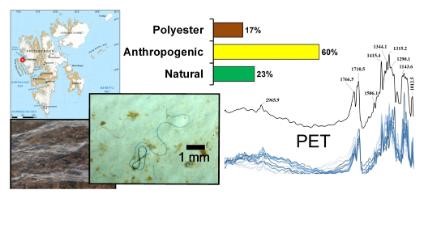
Figure: Location of the studied area, type of microplastics found and an image of one of the fibers fund and the spectra that allows its identification / Science of the Total Environment
Cerdanyola del Vallès, September 2nd 2020. It is called microplastics to plastic fragments with a size under five millimeters. They come from twosources: from the degradation of big plastics that break up in increasingly smaller pieces, and from domestic products that contain small plastic particles, such as exfoliants and toothpaste, among others.
As a consequence of the massive use of these kind of products, microplastics end up in the environment. Until now its presence had been confirmed in the oceans, rivers and even the digestive system of some animals who ingest them.
In a recent work, it has been demonstrated for the first time the presence of microplastics in the Arctic freshwater ecosystems. Most of the microplastics found in the lake are polyester fibers, a widely used material in the textile industry and as a coating material due to its durability.
The discovery was made thanks to a collaboration, led by the researchers Francisca Fernández-Piñas and Roberto Rosal, between research groups from the Spain’s Autonomous University of Madrid (UAM), University of Alcalá (UAH) and the Spanish Institute of Oceanography (IEO) and the ALBA Synchrotron. This collaboration allowed the used of three different spectroscopic techniques: RAMAN, Fourier-Transform Infrared microspectroscopy (micro-FTIR) and Synchrotron Radiation micro-FTIR (SR-FTIR). This last one was carried out at the MIRAS beamline in the ALBA Synchrotron.
“We are before the first work that confirms the presence of microplastics in a freshwater lake in the Arctic. Until now, it had been demonstrated that microplastics were present in the marine ecosystems of the Arctic: in the sea water, in the ocean sediments and even in the ice, but we didn’t know that they had arrived up to the arctic freshwaters”, state the authors.
Few ecosystems free of microplastics
According to the authors, the freshwater lakes in polar zones such as the Arctic were a few of the ecosystems that seemed free of microplastics in the planet. “Today it looks like the ecosystems free of microplastics in the planet are already rare, even more when recently researchers from the Newscastle University have found microplastics even in a small animals that live in the sea beds, between the 7.000 and the 10.890 meters deep”, they say.
“In these exceptional times it opens up unique possibilities – add the authors-. We have found that individual actions have global consequences that, although they may seem roundabout and distant, they end up directly and closely affecting our lives”.
The truth is more and more results proof that microplastics are almost all around the planet because of the human activity. “Today more than ever it opens up the possibility to become aware about recycling, the reuse of plastics and the environmental danger of mostly the single use plastics”, conclude the authors.
Referencia: González-Pleiter, M., Velázquez, D., Edo, C., Carretero, O., Gago, J., Barón-Sola, A., Hernández, L.E., Yousef, I., Quesada, A., Leganés, F., Rosal, R., Fernández-Piñas, F. 2020. Fibers spreading worldwide: Microplastics and other anthropogenic litter in an Arctic freshwater lake. Science of the Total Environment 722, 137904. https://doi.org/10.1016/j.scitotenv.2020.137904
Link to the original news: Detectan por primera vez microplásticos en un lago de agua dulce del Ártico - UAM




